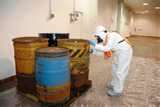
Year in Review: A Tale of Two Regulations
One completed OSHA action ushered in the era of workers' right to understand, while a still pending crystalline silica rule could have international significance.
- By Jerry Laws
- Dec 01, 2012
Oh, the calamity.
The safety-related and health-related events that mark almost any year as significant are calamitous, as a rule, and while many of 2012's most notable events were large and harmful events, two regulatory matters -- one action that OSHA completed, the other a proposed but uncompleted action -- ranked near the top in both categories.
OSHA published a final rule in March 2012 revising its Hazard Communication Standard, 29 CFR 1910, to conform it to the Globally Harmonized System of Classification and Labelling of Chemicals, known as GHS. This completed action modernized and harmonized the HazCom Standard to an international format, and it ushers in the workers' "right to understand" era in place of what HazCom had been, the "right to know." The uncompleted action is OSHA's proposed rule setting new exposure limits for workers who are exposed to crystalline silica. The rule has been bottled up since February 2011 at OIRA, the Office of Management and Budget clearinghouse for federal regulations, even though the silica hazard took on new urgency for both OSHA and NIOSH in May 2012 when the latter agency released a report about its air sampling at hydraulic fracturing sites in Arkansas, Colorado, North Dakota, Pennsylvania, and Texas.
At every site where sampling took place, the full-shift personal breathing zone exposures to respirable crystalline silica exceeded OSHA's PEL, the NIOSH Recommended Exposure Limit, and the ACGIH Threshold Limit Value; in fact, 36 of the 116 samples (31 percent) exceeded the NIOSH REL by a factor of 10 or more. The report's authors recommended that silica exposure be evaluated at all U.S. fracking sites and that effective controls be implemented, if necessary.
In some quarters, OSHA’s pending silica standard is seen as having international significance, given the growing use of hydraulic fracturing in natural gas exploration around the world.
Safety and Health Milestones of 2012
While both OSHA rulemaking efforts stand a good chance of having a lasting, beneficial impact on the lives of millions of workers and their families, the most significant health care event of 2012 was a landmark legal decision, and a hurricane was one of the most memorable safety events during the year.
A plurality, 37 percent, of the voters in an OH&S online poll during November agreed the OSHA HazCom Standard's adaptation to GHS was the biggest safety story of the year. An almost identical percentage chose Hurricane Sandy. Two other events received 12 percent and 11 percent of the votes, respectively: the Costa Concordia cruise ship disaster, with criminal charges filed against its captain, and OSHA's decision to withdraw a proposed safety regulation on children working in agriculture.
Two of the biggest international safety stories of the year involved Britain's Health and Safety Executive. It implemented a cost recovery scheme named Fee for Intervention on Oct. 1, with violators of safety and health regulations required to pay HSE's inspection, investigation, and enforcement costs. On Nov. 26, the agency's Office for Nuclear Regulation granted the first new site license for a UK nuclear power plant in 25 years.
Voters in another online poll chose the U.S. Supreme Court's 5-4 decision to uphold the constitutionality of the Affordable Care Act as the biggest health story of 2012. Coming in second was the hantavirus outbreak at a Yosemite tent camp (The National Park Service announced Sept. 13 that three people who developed hantavirus pulmonary syndrome had died and six other people were recovering.) Voters' third choice was the multistate fungal meningitis outbreak linked to contaminated injectable steroids, with 18 percent of the voters choosing it as the year's top health story.
The health reform law's ultimate impact is hard to predict. At this writing, it was unclear how the states' health insurance exchanges will function or how many governors will reject the Medicaid expansion. Reining in health costs won't be easy: CDC's Morbidity and Mortality Weekly Report in November 2012 reported the prevalence of diagnosed diabetes rose in every U.S. state between 1995 and 2010, and it increased by 100 percent or more in 18 states during that period. States with the largest increases were Oklahoma (226 percent), Kentucky (158 percent), Georgia (145 percent), Alabama (140 percent), and Washington (135 percent).
"In 1995 only three states, the District of Columbia, and Puerto Rico had a diagnosed diabetes prevalence of 6 percent or more. By 2010, all 50 states had a prevalence of more than 6 percent," said Ann Albright, Ph.D., R.D., director of CDC's Division of Diabetes Translation. "These rates will continue to increase until effective interventions and policies are implemented to prevent both diabetes and obesity."
King County, Wash., has long been a leader in sudden cardiac arrest survival through a community responder CPR/AED program. King County officials announced Aug. 31 that the cardiac arrest survival rate there had reached an all-time high of 52 percent –- far higher than the survival rates in most other U.S. locations, which are around 10 percent, according to King County EMS/Medic One. County Executive Dow Constantine announced the number when he released the EMS/Medic One 2012 Annual Report.
"Fast response during traumatic events like a heart attack is critical, and these new findings once again affirm the skill of our dispatchers who take 911 calls and the professionals who provide rapid, high-quality emergency care and transport," said Constantine, who thanked the voters of King County for their long history of support for the service.
About the Author
Jerry Laws is Editor of Occupational Health & Safety magazine, which is owned by 1105 Media Inc.